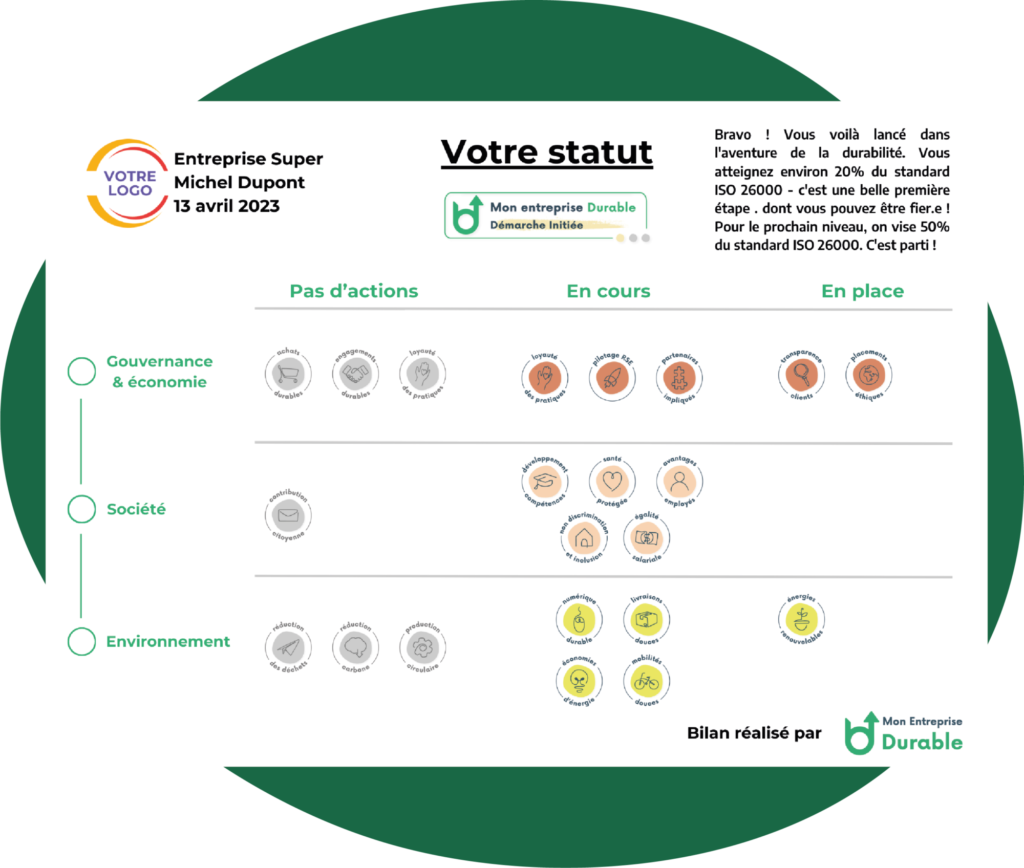Discover the CSR tools you need to manage your approach
Over the past few years, ecological awareness has grown steadily in our society.
As a result, CSR issues have gained a central place in corporate concerns.
CSR represents the contribution of profit-making structures to sustainable development.
However, it’s not easy to adapt an already established operation to a new policy that risks upsetting habits.
The incorporation of a CSR approach into a company needs to be carefully thought through and carefully supervised.
This is the role of CSR tools.
These tools, which are numerous and varied, ensure that the actions set out in the plan are precisely monitored and properly regulated.
They also enable us to keep abreast of changing circumstances.
CSR tools are the key to successfully implementing your action plan!
Our article gives you a few pointers and a summary of the different CSR tools you can use in your company!
Key points of the article
Implementing a CSR approach in your company
Corporate Social Responsibility, or CSR, is a company’s involvement in sustainable development issues.
It means anchoring sustainability in the life of a company through a carefully thought-out action plan.
Integrating a CSR policy into your company is a meaningful step, but one that also offers many advantages for your company’s growth.
CSR is perfectly suited to the long term, breathing new life into a company’s activities.
It will also have a strong impact on the company’s image.
Indeed, integrating a CSR policy demonstrates the company’s commitment and strong values.
It’s a point that makes it human, accessible and can be a major point of difference on the market.
On the other hand, the implementation of a CSR action plan will involve changes, and can therefore lead to certain savings.
It also provides a pleasant and stimulating working environment for employees.
What is a CSR policy?
It takes the form of an action plan and the CSR tools needed to implement it.
However, before the latter can be defined and drawn up, a study phase is necessary.
This stage is called “diagnosis”.
For the organization, it consists in examining the DNA of this future policy.
It involves questioning the meaning of the company’s activities, the impact it wishes to make, and how to get everyone involved in following these new sustainable objectives.
The company will determine its raison d’être, the guideline for its program, but also observe how it relates to it.
To this end, a number of data will be collected and studied.
For example, the employee satisfaction index, the level of waste or greenhouse gas emissions, the consistency of practices with current standards, respect for professional ethics, the possible presence of renewable energies… Many companies already have a few basic CSR approaches; all they need to do is develop them and increase their impact!
More concretely, the diagnosis assesses the company’s level of maturity with regard to CSR issues.
It is an assessment based on several points:
- Determine the company’s current positioning with regard to the 3 CSR pillars
- Define purpose and commitments
- Prioritize stakeholders
- Identify the company’s strengths and weaknesses
- Prioritize issues
The diagnosis is the foundation of the CSR action plan and the resulting actions.
Its role is not only to establish the company’s position, but also to set out a precise methodology for implementing its actions and monitoring their progress.
The action plan can be carried out in-house, or with outside help.
With tools, for example.
CSR tools can be found throughout the development of the program, each acting in a different way on one or more CSR levers.
Let’s take a closer look.
CSR tools and their impact on your company
A number of tools can be put in place to ensure that a company’s CSR initiatives run smoothly.
Most of these tools are designed to meet the requirements of ISO 26000.
As a reminder, ISO 26000 is the international standard dedicated to CSR.
It defines the 7 different principles on which a CSR policy is based.
It defines a framework for all organizations in their strategy, with the following 3 goals:
- Contribute to sustainable development and the improvement of living conditions in society
- Move forward in compliance with the law, possibly suggesting improvements
- Delivering the best possible response to stakeholders
The ISO 26000 standard is the guiding principle for CSR companies, and action plans must be fully in line with its principles.
As far as tools are concerned, they are grouped around the 3 CSR pillars: social, environmental and economic.
Some act on several pillars – multidimensional tools – while others focus on a single pillar – unidimensional tools.
These tools are also specific to diagnostics and action plan deployment.
For example, software for diagnosing and communicating actions.
The social pillar includes several tools linked to the principle of governance.
The aim is to provide healthy, ethical working conditions and relationships that respect everyone.
Governance thus represents a major responsibility for the company’s Board of Directors.
The following tools, among others, are available:
- Evaluation forms to measure the satisfaction index
- A self-assessment system for the Board of Directors
- Drawing up a code of ethics
- Creation of a dedicated CSR committee
- Risk assessment and management systems
- A human resources charter based on parity, diversity and environmental criteria.
- Gender quotas, a continuation of human resources tools
Our social pillar tools are adapted to the challenges and developments facing our company.
Their aim is to ensure that CSR policy is always in line with current standards and company developments.
They often need to be adapted or perfected.
For the environmental and economic pillar, there are a number of tools to highlight their commitments and their positive impact on the environment.
These include tools, but also labels.
The latter show that these commitments are recognized and validated by the outside world.
Tools such as :
- The Carbon Footprint is used to measure a company’s greenhouse gas emissions.
This tool is compulsory, but is a good way of demonstrating a company’s CSR impact. - Life Cycle Assessment (LCA) is a tool for quantifying the environmental impact of a product during all phases from design to sale.
For companies producing materials, this tool analyzes the materials used during production and the methods used to dispose of defective or end-of-life products.
The labels mentioned above are also excellent CSR tools.
They enable you to promote your CSR approach to the public, as well as internally.
All companies with a CSR policy and a certain length of service can apply to be assessed.
The following are just a few examples:
- B-Corp: created in 2006 in the United States, it has been active in France since 2015, evaluating the global performance of companies.
It works to combat inequality, poverty and a polluted environment.
It rewards companies that meet CSR requirements and re-evaluates them every 3 years. - Lucie: created in 2007, this is a benchmark CSR label.
Based on the ISO 26000 standard, it attests to the seriousness of a company’s commitments.
It also provides a follow-up for the assessed company, to give it a clear idea of where it stands and how it is progressing.
An award-winning company is reassessed after 18 months. - Engagé RSE: this is a certificate created by AFNOR.
This attestation assesses a company’s overall performance against the ISO 26000, SD 21000 and Global Reporting Initiative standards.
It rewards them if they meet the criteria, and awards them its logo for 3 years.
Finally, while CSR reporting may seem obvious, its effectiveness is substantial.
It is a clear and precise assessment of the impact of the company’s activities from an economic, environmental, social and societal point of view.
It represents a clear and transparent approach to the positive influence of CSR policy.
It is extremely useful, as it enables companies not only to assess themselves, but also to demonstrate the credibility of their commitment to customers and partners.
Reporting is a real showcase for a company’s investment, and is often closely scrutinized.
There are many different CSR tools available to support the action plan and assess its impact.
The tools chosen each have their own specific properties, and can thus support a CSR policy across the various pillars.
CSR tools also represent a means of enhancing a company’s commitment and setting itself apart in the marketplace.
It’s important to choose them with care, to ensure that your company’s CSR approach continues to improve!
10 examples of CSR actions to implement
CSR actions relating to the social pillar
Our aim is to provide a healthy and ethical working environment.
Employees are expected to respect their rights.
Here are a few examples:
- Ensuring equal pay for men and women, including in recruitment
- Offer teams sports and team-building activities.
Ensure air quality - Promoting diversity
- Offer a shared garden / provide healthy food for employees
CSR actions relating to the economic pillar
The aim is to limit waste and turn to approaches that promote the local economy.
Transparency and ethics are at the heart of our approach.
Here are a few examples:
- Give preference to local partners.
- Develop partnerships with community organizations
- Impose sustainable standards on suppliers
CSR actions relating to the environmental pillar
The aim is to reduce the company’s environmental impact.
To achieve this, a company can focus on actions that keep polluting processes to a minimum.
Here are a few examples:
- Allow more teleworking or set up a commuting plan to reduce CO2 emissions
- Favoring renewable energies
- Set up a recycling system (limit paper consumption, compost)
In conclusion, CSR tools represent a real lever for success and credibility for the CSR actions implemented by a company.
It’s an opportunity to highlight a strong, human and decisive commitment in today’s society.
Corporate CSR tools act in their own way on the social, economic and environmental pillars.
Companies act with a stable, personalized approach.
As mentioned above, the tools are a support, but also a real guarantee of quality.
They can even give a company a competitive edge.
Adopting a CSR policy is therefore an adventure as human as it is advantageous for a company.
Setting up a CSR policy may seem a tedious task, but all it takes is commitment and conviction!
What do you think of CSR tools and their impact?




